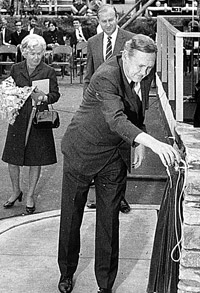History
Introduction | Chronology | CSIRO and ANBG | Jervis Bay annex | Foundation report
Chronology
1933 July
Advisory Council of Federal Capital Territory recommends the setting up of Gardens to the Minister for the Interior.
1935 Sept
Dr B T Dickson submits report to the Advisory Council recommendng site etc for Gardens. This has come to be known as the Dickson Report.
1941 Nov
Dr Edwin Gauba starts collecting herbarium specimens while a prisoner at Loveday Internment Camp in the SA mallee, later to form part of the CBG Herbarium.
1944-1958
Lindsay Pryor appointed Superintendent of Parks and Gardens for Canberra, part of the Department of the Interior.
1945 Sept
Pryor recommends start on Gardens. (budget of 1000 pounds for six months) 1948 A few eucalypts planted by Pryor on site for Gardens.
1949 Sept
Ceremonial planting of first trees by Prime Minister Ben Chifley and Director of Kew Gardens, Sir Edward Salisbury.
1950
Dr Edwin Gauba appointed (temporary) botanist for the Dept of Interior Parks and Gardens section, initiating the herbarium that became the CBG Herbarium.
1950 Sept
Eviction notices sent to grazing lease holders of Gardens site on side of Black Mountain.
1951
Pryor proposes site and area for Jervis Bay and Mt Gingera Annexes.
1951 Oct
400 trees planted at Jervis Bay Annexe on New South Wales south coast.
1952 Jan
Approval for alpine Annexe at Mt Gingera from Secretary Dept of Interior.
1958
David Shoobridge appointed Director of Parks and Gardens.
1960 June
Dr Betty Phillips appointed first Botanist for the Gardens.
1960 Aug
Questions in the Commonwealth Senate confirm 'indegenous' nature of Gardens collection.
1964
Herbarium contained 15 000 specimens.
1965
First Index Seminum seed catalogue produced by Gardens.
1966
Herbarium, Office, Library, Gardener's Depot and 3 cottages completed in Gardens. Herbarium collection moved from temporary storage of suburban house.
1967 Sept
Gardens open to public for first time.
1967-9
Construction of first two glasshouses at Nursery.
1970 Oct
Official opening of Gardens by Prime Minister John Gorton.
1971
First edition of Gardens' annual publication Growing Native Plants.
1978 Dec
'Canberra Botanic Gardens' re-named 'National Botanic Gardens'.
1979
Aboriginal Trail established in its present form with logo and photometal interpretive signs installed
1980 April
First plantings in newly completed Rock Garden.
1981
Last Index Seminum seed catalogue produced.
1981 Aug
International Association of Botanic Gardens (IABG). conference hosted by Gardens.
1984 May
'National Botanic Gardens' re-named 'Australian National Botanic Gardens'
1985 Nov
Opening of Visitor Centre by Prince and Princess of Wales.
1990
200 000 specimens in CBG Herbarium.
1990 Oct
Official launch of Friends of ANBG by Lindsay Pryor at Biota'90 open days celebrations.
1991 March
`Protective Custody' endangered plant conference hosted by ANBG
1992
Feb First intake of Voluntary Guides start 10-week training course.
1992 April
First publication of Musci Australasiae Exsiccati by CBG Cryptogam herbarium.
1992 Oct
Publication of souvenir guide book for Gardens.
1992 Dec
First intake of students under CBG Herbarium Intenship Scheme.
1993 Feb
Memorandum signed to establish the Centre for Plant Biodiversity Research
2000 April
New 10 year agreement signed to maintain the joint management of the Centre for Plant Biodiversity Research by ANBG and CSIRO.
2003 May
Launch of the Fungi web site, sponsored by Friends of ANBG.
2004 July
ANBG added to Commonwealth Heritage List recognised by EPBC Act .
2008 May
Botanical Resource Centre, with Public Reference Herbarium, opened next to Friends' Lounge.
2008 Nov
Launch of National Action Plan for Role of Botanic Gardens in Climate Change.
2009 Oct
Directional 'street signs' installed throughout the Gardens to aid visitors.
2010 Oct
Grassy Woodland section, near front gate, redeveloped with board-walk.
2010 Dec
New agreement signed with CSIRO, CPBR becomes CANBR, Centre for Australian National Biodiversity Research.
2011 Feb
First non-potable water, pumped from Lake Burley Griffin, piped through the Gardens irrigation system.
2011 June
New logo and corporate branding signed off by Director National Parks for an October implementation.
![Director of National Parks [logo]](../../../images/dnp_90px.gif)





